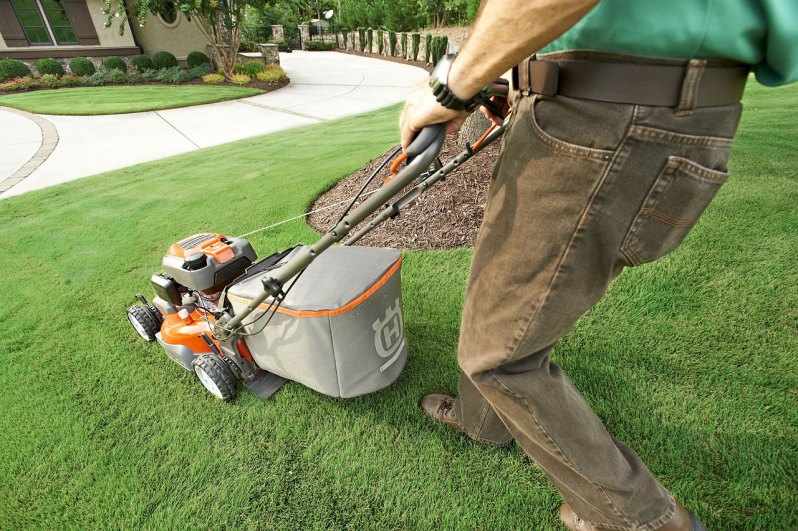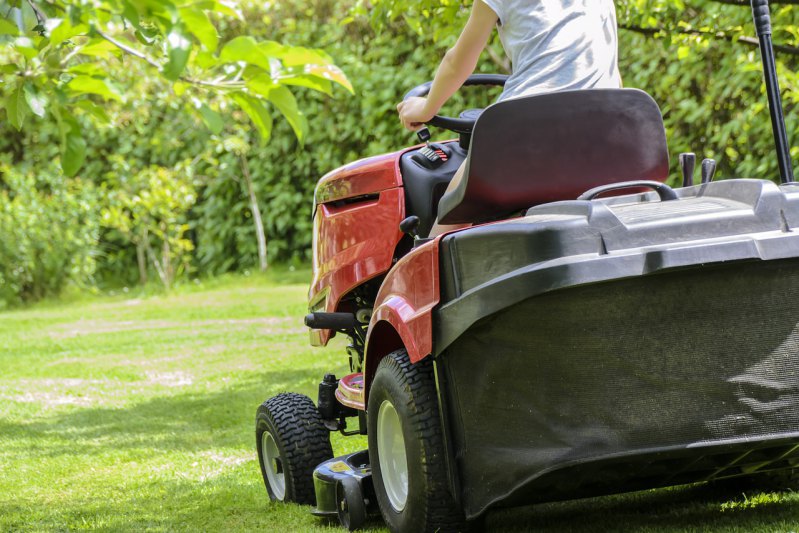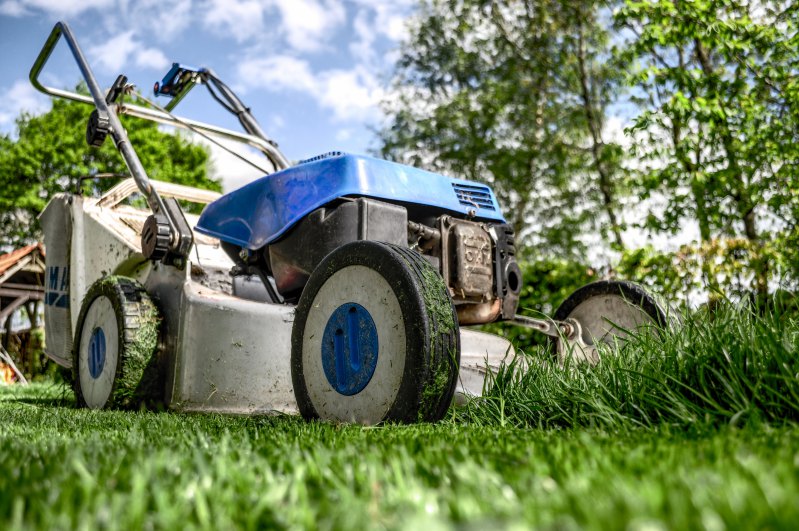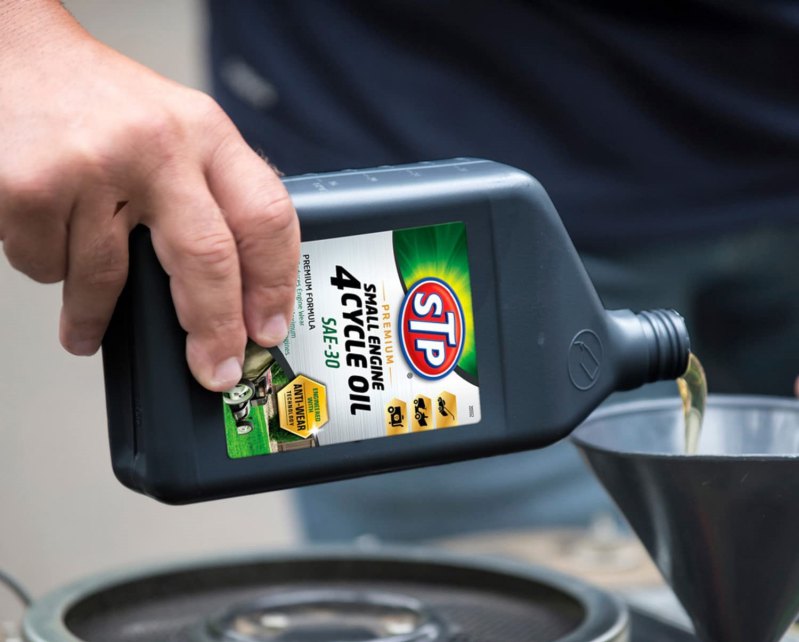Is your Lawn Mower not working efficiently? Is it not shaping the grasses?
If the answers to the preceding questions are correct, it is feasible that your mower requires maintenance, particularly an oil change. Oil must be changed on a regular basis in order for the device to function properly.
However, the main issue is how to change the oil in a mower. So, in this video, we’ll go over some steps for changing the oil in a mower.
What is a Lawn Mower?
Before jumping on the steps to change the oil in a lawnmower, firstly let’s discuss what is Lawnmower is and its types, benefits, and much more.
A lawnmower is an agricultural machine that is used to cut or trim grass to an even height. It can cut grass with various axes. Rotary lawnmowers, for example, use a scalpel blade that twists about one single vertical axis, whereas cylinder or reel mowers use a having to cut bar and numerous blade assembly that spins about a single horizontal plane.

Furthermore, some larger lawn mowers either are self-propelled “walk-behind” types or, more commonly, “ride-on” mowers, with the operator riding on the mower and controlling it like a robotic lawnmower, which is designed to run either entirely on its own or, less commonly, by an operator via remote control.
Types of Lawn Mowers
Lawnmowers are of several types ranging from robotic mowers to gas mowers and much more. So, let’s understand some of them.
This Post Contents
Push mower
It is a reasonably priced lawnmower. They do require more physical work to continue operating, but they are an effective lawn tool to have on hand if you need to preserve a small-to-medium lawn and hope to have some calorie-burning exercise in the process. Push mowers, depending on the type, can also be softer and easier to manage than other common types of mowers, such as self-propelled lawn mowers and riding leaf blowers.
Self-propelled mower
Controls are simple to use, and the drive wheels are powered by a transmission. Self-propelled mowers come in solitary and variable speed configurations. They function by activating a speed control lever, which causes the device to move forward.
Self-propelled mowers could be front-wheel drive, rear-wheel drive, or all-wheel drive. Front-wheel drive tractors are simple to operate and allow users to switch the mower by simply tipping the front wheels back and lifting them off the ground. They are excellent for flat lawns.
Hover Mowers
Hover mowers are fueled rotary push lawn mowers with a propeller above the rotating blades that drives air downward, creating compressed air that elevates the mower above the floor. As the mower floats over the grass, the operator can easily maneuver it.

Riding Mower
A riding mower, which you might know as a ride-on lawnmower or some of you might know it otherwise as a tractor lawnmower, is one type of grass cutter in which the operator sits if compared to mowers that are pushed or towed unlike some of the other mowers. Although, the setback of this kind of mower is that it gets hot so the operator might have to take care of wearing a really thick pair of boots in order to provide safety against that heat.
Robot mower
An industrial robot mower is an automatic machine that is used to cut grass on the lawn. A typical robotic lawn mower requires a user to install a border wire around the lawn to define the area to be mowed. This wire is used by the robot to determine the dividing line of the region to be trimmed and, in some cases, to locate a charging dock. Robotic mowers can maintain up to 30,000 m2 of lawn.
Rotary leaf mower
Rotary leaf blowers have a scalpel blade that rotates laterally beneath the mower, similar to a plane’s propellers. Rotational lawn mowers are most versatile and can handle most kinds of grass. They cut longer and rougher grass better than cylinder mowers. A rotary mower can be powered by a mains electric motor, a rechargeable battery, or a gasoline engine.
Cordless lawnmower
Battery-operated rechargeable batteries leaf blowers are a convenient garden tool. They have all of the advantages of an electric mower, but there is no need to fret about a cable. However, because of the battery, they can be more costly than main power electric models. Contemporary lithium batteries are softer and last far longer than nickel-cadmium batteries, and they’re more expensive.
Cylinder mowers
The cylindrical blades on cylinder lawnmowers rotate vertical position in front of the mower. They cut solutions in the form at the bottom of the machine. The canister should have several blades, preferably three or more. Cylinder lawnmowers are ideal for flat lawns that need to be kept short and well-kept. Mowers can be electric, gasoline-powered, or push-type.
Benefits of using Lawn Mower
Lawn Mowers have several benefits including you have the independence to manage your garden and much more. Let’s discuss some of them :
More even growth is observed- Among the most prevalent lawn problems is uneven growth, which can be avoided by mowing on a regular basis. Regularly cutting the grass to a suitable height improves overall growth by allowing for even absorption of nutrients from moisture and the sun. Remember that continuity in growth is essential for maintaining a beautiful yard.

Lawn recovers fast from pest issues- Pests, inclement weather, and disease will undoubtedly plague your lawn at all times. A yard that is regularly mowed and maintained will recover faster than an unhealthy one. Bear in mind that the longer the lawn goes without adequate treatment, the more challenging it will be to restore it to its former glory.
Control Pests in the Garden- Pests will easily infest an overgrown lawn. High grass and weeds are both ideal habitats for rats and bugs, which can degrade the image of your garden and spread the disease.
Pests can be discouraged by cutting the grass on your lawn on a regular basis. However, if your lawn is already infested with pests, you should think about investing in professional pest services right away.
Indeed, maintaining up with regular cutting of the grass is essential if you want to have an appealing, healthy lawn. One of the most important things to remember is not to cut more than 1/3 of the grass’s height because this can severely damage the roots. However, if you want to be sure that you’ll reap these benefits, hire a professional to take care of your lawn.
Lawnmower helps in the Mulching of Garden- Mulching is an important part of maintaining a lovely, healthy lawn because it helps return much-needed nutrition to your lawn after cutting the grass. Consistent mowing results in a steady supply of mulch composed of shortened grass blades, which is more nutritious than having to wait for the grass to grow longer. One thing that you have to keep in mind is that the longer the grass blades, the weaker it is and on top of it all contains fewer nutrients.
Garden Grass gets stronger -Mow your lawn as often as necessary to achieve a strong lawn. When the grass is cut at the proper height, the good healthy grass shoots thrive while the weak ones die. As a result, the more you trim your grass, the healthier your grassroots level will be. Over time, this results in a healthy, more lush lawn.
Disadvantages of using a lawnmower
There are several disadvantages of using a lawnmower as with other devices:
- Lawnmowers are generally dirty and noisy, though some replacement battery models are mumble incoherently quiet and do not pollute the neighborhood.
- A lawn must be fed on a regular in order to look good. Grass seedlings have a voracious appetite in order to maintain their health. A lawn will lose vitality and its ability to withstand illnesses and insect damage if it is not fed on a regular and timely basis with properly balanced fertilizers containing special micro-nutrients.
- Some lawns may require additional irrigations at different times year-round, but this can be greatly reduced by planting the appropriate type of grass for targeted areas. Trying to germinate seeds in areas that require daily watering is not a good idea.
Maintenance of Lawn Mower
Just like any other device, a lawnmower also needs maintenance to work efficiently. So, let’s discuss some of the maintenance tips of Lawn Mower.
When to perform lawn mower maintenance?
Lawnmower repairs can be done at any time of year, but the best times are at the start of the season before the first mow, and at the end of the season when you’re putting your mower away till next year. It should be noted that timing will vary depending on location.
The end of the mowing period is an ideal time to execute annual lawnmower repairs but there are certain things you must do to keep it in good working order when it is left unused for months at a time.
Clean out the lawnmower
Clear out all of the grass and other debris that has accumulated on the tail section during the mowing season to improve performance.
Sharpen and stabilize the blades
Even if your lawn is free of branches, rocks, and foreign material, the blades will deteriorate over time. You can sharpen the propellers yourself, but unless you’ve mastered the technique, this is one step you should leave to the lawnmower service workers.
Remove or disconnect the spark plug. You should replace the spark plug once a year to ensure that your mower starts easily, but having taken it out at the start of upkeep is also a great idea for safety, as it precludes the mower from starting accidentally.
Get to know your vehicle’s owner’s manual. You don’t want to damage your lawnmower, so make sure that you understand how and where to care for it according to the manufacturer’s instructions. These guidelines are provided to ensure that your mower lasts as long as possible.
Oil should be replaced or topped up. Consult your lawn mower’s owner’s manual to gain knowledge on how to change the oil correctly and what type of oil to use. If your mower’s oil is old or contaminated, drain it and replace it with new oil. Make certain that the oil is properly disposed of. The majority of towns have free oil recycling centers.
Fog the engine
If your mower sits idle during the winter, the oils in the engine can deteriorate over time, allowing water in the air to cause corrosion and damage. This can be avoided by using fogging oil. Check your owner’s manual to see if your lawn mower’s engine needs to be fogged, and be sure to follow the instructions exactly.
When Should You Change Your Oil?
Every 50 hours of operation, or at the end of each mowing season
You should change the oil in a new lawnmower engine after the first five operating hours.
Also, It is advised that you should inspect the oil after each use. When you are using the lawnmower in tough conditions like muddy ground, high temperatures, extreme dust, and rough or hilly soil, the lawnmower will require frequent oil change compared to when you are using it on an even grass-filled soil.

Steps to change the oil in Lawn Mower
When you put new oil in the crankcase, it should be golden or amber in color. Heat, dirt, and agitated air accumulate in the crankcase over time, which has caused the oil to darken. Gloomy oil is not only dirty; this has lost a significant amount of its capacity to coat and defend engine components.
Step-1: get ready to the changing the oil
- To change the oil, first, remove the old oil from the motor. However, there are a few procedures you must follow in order to eliminate oil from lawnmower engines.
- Start the engine.
- Getting warmed up the electric lawn engine allows the oil to flow more freely, which speeds up the oil change. It will also be easier to remove all of the residual oil from the engine.
- Clean the area around the oil fill.
- Clean it up all around the oil fill area with an air pump or a clean towel.
- Get an oil pan capable of catching the oil.
- To capture the oil from the mower, you’ll need an oil filter or something similar. Place the pan on the edge of the mower that will be tipped to deplete the oil.
Step-2: Remove the old oil
- The mower ought to be ready for its oil to be drained, as you’ve already prepared.
- Eliminate the oil plug cap and tip the mower on its side to deplete the oil.
- Allow the mower to rest on its edge for about a minute to allow all of the old oil to drain.
Step-3: Replace the Oil Filter
- The majority of stroll lawnmowers lack oil filters, but many models in the industry include them as part of the engine design. If your mower model has an oil filter, we’ve included the steps for modifying it below.
- If your mower engine does not have an oil filter, proceed to Step 10 to finish your oil change.
- Prepare something to catch the oil if it drips from the filter.
- Unscrewing your mower’s oil filter will cause it to spill the oil it contains.
- Find something small enough to fit under the filter to catch the oil as you unscrew it.
Remove the old filter
- The old filter unscrews easily.
- Apply oil to the new filter’s seal.
- Before installing the new oil filter, the seal must be coated with oil to ensure operational efficiency.
- Apply a thin jacket of oil to the outside edge of the filter cartridge with your finger. When you install it, this thin jacket of oil will make sure that it seals tightly.
Replace the oil filter
- Screw the fresh oil filter into the location until it tries to touch the plate against which it seals. Then, tighten the filter with a solid 1/4 or 1/2 turn. If you fail to tighten the filter, you might face problems like spillage of the oil and that will just add up to your tasks.
Conclusion
When it comes to certain gardening products, you always have to take care that you are taking enough and proper care, you invest a lot of money to ensure that you are getting a cost-efficient tool but if you fail to take care of it and maintain it as it requires to be maintained, it will not work as efficiently as it should. You should now understand how to modify or change the oil in a lawnmower, as well as what lawnmowers are, their benefits, types, maintenance, and drawbacks, among other things. Even if your lawnmower isn’t working properly, you can easily switch its oil and maximize its efficiency with the assistance of this article.